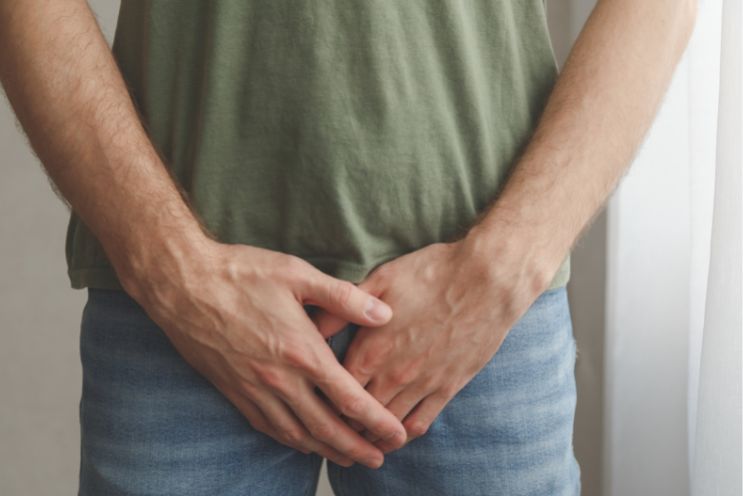Table of Contents
ToggleOverview
Noticing red spots on the penis can be alarming, but it is essential to remain calm as they don’t always signify something serious.
Red dots on the penis can result from irritation or poor hygiene. Such spots may disappear in a few days. In contrast, red spots that develop due to another condition or a sexually transmitted infection (STI) tend to last longer and present with other symptoms.
Read more to discover the possible causes of red bumps on the penis head and the treatment.

Concerned about red spots or bumps on your penis?
Your Doctors Online offers fast access to specialists who can identify the cause, whether it’s an infection, poor hygiene, or something more serious. Get a personalized diagnosis and treatment plan.
Get an instant consult and care right now!What Do the Red Bumps Look Like?
The red bumps on the penis can present as red dots on the penis head, raised bumps, fluid-filled bumps, or clusters of bumps. You may also experience white bumps on the penis, red spots under the foreskin, a blister on the penile shaft, or an irritating itchy penis head. You may also notice a single red bump on the penis or a blister on the penile shaft. All these bumps may stem from different causes. Let us explore some of those.
What are the Causes and Treatment Options for Red Spots on The Penis?
The following are some of the causes that can lead to red spots on the penis:
1. Poor hygiene
Improper hygiene is a common cause of red or pink dots on the skin of the penis. If genital hygiene is not maintained, it can lead to rashes or red dots on the penis. These are commonly experienced by men who work out or play sports frequently. In addition, excessive sweating and improper cleaning can lead to small red bumps on the penis head.
Treatment
To avoid this, you should bathe daily and clean the area with a bar of gentle soap and warm water. Furthermore, wearing cotton underwear will help keep the area well-ventilated. Men who sweat excessively should bathe multiple times a day.
2. Balanitis
Balanitis is the inflammation of the penis head, also called the glans. Poor hygiene, an allergic reaction, a yeast infection, or an STD can cause this inflammation. The symptoms reported include redness under the foreskin, not itchy, pain while touching or urinating, and burning. Men are more prone to develop Balanitis if they are uncircumcised.
Treatment
Some cases of Balanitis are resolved by improving genital hygiene. Washing the penis regularly using natural, unscented soaps and the area under the foreskin can also help prevent Balanitis. However, the infection must be treated if symptoms do not improve in a few days. Conditions are treated with topical or oral antifungals or antibiotics. Doctors commonly prescribe:
- Steroid creams (hydrocortisone)
- Antifungal creams (clotrimazole)
- Antibiotics (metronidazole)

Not sure if the red spots on your penis are harmless or require urgent care?
Your Doctors Online provides 24/7 access to expert doctors to help you understand your symptoms and get treated quickly. Don’t wait—get answers now.
Get instant diagnosis and treatment right now!3. Genital herpes
Genital herpes is typically caused by the herpes simplex virus (HSV-2 or, less commonly, by HSV-1). This virus is introduced in the body during unprotected sex with someone who is infected or carries the virus. This can result in red spots or bumps/blisters on the following regions of the body:
- Scrotum
- Penis
- Thighs
- Buttocks
- Mouth
Other symptoms that may accompany these bumps include:
- Pain
- Itching
- Bleeding sores/ulcers
- Scab formation once the sore heals
Treatment
Genital herpes isn’t curable, but your doctor will prescribe antivirals such as valacyclovir or acyclovir to manage your symptoms and prevent the disease from spreading.
4. Contact Dermatitis
The genital region is considered a sensitive area of the body. Therefore, harsh chemicals in certain products, such as soaps or moisturizers, can cause Dermatitis on the penis.
Therefore, the gland can become red and swollen, along with the appearance of red dots on the skin. Finally, red spots under the foreskin that are not itchy may also develop.
Some men may have sensitivity to certain fabrics, and irritation may result in small bumps on the penile shaft that don’t itch. Therefore, wearing clothing made of synthetic-based materials does not allow air to reach the genital skin resulting in spots on the shaft of the penis.
Contact dermatitis is caused when the skin comes in contact with an allergic substance. Symptoms that result from this include the appearance of fluid-filled blisters filled, which tend to burst. Other symptoms include swelling, itching, and scaly or dry skin around the base of the shaft. You may also notice spots on the foreskin when pulled back.
Treatment
Contact dermatitis may not require treatment as symptoms can disappear after exposure to a specific chemical or product is discontinued. Avoid the use of scented or chemical products in the genital area. Also, wear cotton-based underwear to prevent Dermatitis. However, mild topical or oral corticosteroids are sometimes required to manage signs and symptoms.

Are you worried about genital symptoms like red spots, bumps, or irritation?
Talk to a doctor online at Your Doctors Online and get personalized advice to resolve your concerns safely and swiftly.
Start your consultation right now!5. Yeast Infection
Apart from the causes mentioned above, a yeast infection termed candidiasis is another common cause of red spots on the penis. The overgrowth of Candida albicans fungus causes a yeast infection. Consequently, this overgrowth results in intense itching, swelling, and red, purple, or white spots. Yeast infections can occur both in men and women, although they are more common in women.
Treatment
Yeast infections are treated with antifungal creams or ointments. Commonly prescribed creams include fluconazole or ketoconazole. Additionally, adequate hygiene is essential to prevent disease or worsening of the existing one. Oral antifungals are usually prescribed for severe infections or infections that do not settle with topical creams. To avoid re-infection, it is also essential for sexual partners to be treated
6. Syphilis
Syphilis is a sexually-transmitted infection (STI) caused by the organism Treponema pallidum. It can lead to the development of a painless small lump on the penis. Moreover, this is one of the first symptoms, and you may notice a red, circular sore on your penis. This disease is spread through unprotected intercourse with someone infected.
If the disease is left untreated, syphilis can progress, spreading the infection in the body. Therefore, prompt treatment is very vital.
As the disease progresses, an individual may experience the following:
- Rash on other parts of your body
- Fever of 101°F (38.3°C)
- Swollen lymph nodes in the groin
- Headache behind eyes
- Paralysis
Treatment
If you suspect you have been exposed to syphilis, you should contact your doctor immediately so that treatment can be started on time to prevent long-term complications. Commonly used over-the-counter antibiotics for the treatment include
- Benzathine penicillin
- Ceftriaxone (Rocephin)
- Doxycycline (Oracea)
You should also refrain from sexual activity until you have a specific blood test result.
7. Pearly Papules
Pearly papules are a result of inflammation of the Tyson glands. These glands are located beneath the penis head. Although these papules are not always visible, they look like small pimples when they are. Also, the color can be whitish, shiny or transparent, or similar to skin color.
Treatment
Pearly papules are benign and hence do not require treatment. They can be treated for aesthetic purposes. Treatment options include cryotherapy or cauterization.
8. Drug Rashes
Taking medications such as anti-inflammatories, analgesics, or antibiotics can lead to side effects such as an allergic reaction on the penis or a rash on the head of the penis. You may also notice bumps on the tip of the penis or red spots in the genital area. You may also develop some blisters. For instance, ingredients in some antibiotics can lead to Stevens-Johnson syndrome, resulting in blisters on the penis. The rash may spread to other areas of the body.
Typically, rashes caused due to drug allergies clear up once people discontinue the medication. However, in severe cases, people may require another medicine, such as an antihistamine or corticosteroid, to help manage the symptoms.
Allergic reactions to drugs can be severe, so it is wise to consult with a doctor to see if your symptoms warrant further evaluation or treatment.
Treatment
If spots or a rash appear after starting a particular medication, you may have a drug allergy. If so, immediately stop using the medicine and inform your doctor.
9. Fordyce Spots
Fordyce granules or spots present as tiny white or yellow spots. Bumps or blisters that form during adolescence and appear on the penis head or shaft are commonly Fordyce spots. This condition is benign and is not life-threatening, so there is no reason to be concerned.
Treatment
These spots are harmless and do not require any treatment. Although tretinoin creams can help reduce the appearance.
10. Friction
Continuous rubbing or friction from clothing or frequent sexual contact can give rise to rashes or spots on the penile gland. Red bumps that result from friction can be accompanied by symptoms such as itching, the tip of the penis burning, and mild swelling.
You may also notice a blood spot on the penis from prolonged rubbing. There aren’t any other noticeable symptoms.
Treatment
Wearing underwear made of cotton can prevent friction injury caused by rubbing against rough fabrics. Moreover, good hygiene habits will help to relieve irritation from friction. Using sufficient lubricant during sexual intercourse helps prevent irritation or injury due to sexual activity.
11. Genital Eczema
People with genital eczema may experience intense itching, sore skin, and a rash on the genitals. Individuals with such symptoms should see a doctor to determine whether they have eczema, penis or genital eczema, or a similar condition.
Skincare products, such as shower gel, laundry detergent, antiseptic solutions, or creams, can irritate genital skin and trigger eczema. Profuse sweating and friction from tight clothing are some other triggers. Genital eczema may also result from the use of spermicides and latex condoms.
Treatment
Avoiding harsh skin care products and wearing loose clothing may help relieve symptoms quickly. Topical steroids or emollients help treat the symptoms.
12. Genital Psoriasis
Genital psoriasis is an autoimmune disease that can affect the skin in the genital area. It is also believed to be triggered by stress and infection. Genital psoriasis causes red, dry patches to develop. It is also accompanied by itching and flaky skin.
Treatment
A prescription-strength corticosteroid cream is the mainstay treatment. The cream is applied to affected areas of the skin, which then helps decrease inflammation and discomfort. In severe cases, the doctor also prescribes oral medication. Other options include retinoids like Soriatane and phototherapy.
13. Bowenoid Papulosis
Bowenoid papulosis is a rare condition that is transmitted sexually. The culprit behind the condition is subtype 16 of human papillomavirus (HPV). Also, red spots can appear in the genital region or anal region. However, these usually clear up independently without any treatment, but some people may require treatment.
Treatment
Some treatment options include:
- Topical cream(Fluorouracil)
- Laser surgery
- Cryosurgery
In rare cases, Bowenoid papulosis may progress to Bowen disease, an early form of penile cancer. Therefore, if symptoms persist for months, you must follow up with your doctor.
14. Scabies
Scabies occurs when mites burrow into your skin and inhibit the place after laying eggs. These mites can spread through proximity to an infected person, including sexual activity.
The most prominent symptoms include itching and irritation as the mite burrows into your skin. Other symptoms include dry skin, blisters, and white-colored lines in the skin where mites have burrowed.
Treatment
If you think you have symptoms of scabies, you will require a prescription for a topical cream, such as permethrin or crotamiton, to treat it. You need to consult a doctor and follow their application instructions closely.
15. Molluscum Contagiosum
Poxvirus is the agent that leads to molluscum contagiosum, a skin infection. The transmission mode is skin-to-skin contact or sharing items such as towels, bedding, clothes, and other materials with someone infected.
It causes red and itchy spots under the foreskin and affected areas. However, scratching may worsen the condition causing the infection to spread to other body regions.
Treatment
Molluscum contagiosum can settle down on its own. So, treatment is not essential. The following options are available for treatment:
- Topical therapies
- Curettage
- Laser surgery
- Cryosurgery
Prevention Options for Red Spots on Penis
The treatment protocol is based on the underlying cause of the red spots and may vary from person to person. Although practicing good hygiene by ensuring that you wash the penis daily and changing clothes after exercising can help reduce the chances of infection. Additionally, men with an uncircumcised penis should take special care to clean under the foreskin. This helps prevent bacteria from building up. Furthermore, using a condom during intercourse reduces the chances of contracting and passing on STDs.
What to Do About Red Bumps on Your Penis?
Bumps on the penis can signify distress and shatter a man’s confidence. Therefore, it is better to identify reasons by discussing them with your healthcare provider to avoid misdiagnosis.
When to Consult a Doctor
Although red spots on the penis are mostly benign, they can sometimes be severe. You can consult our online doctor at Your Doctors Online to learn more about your condition. Also, a rash on your penis can indicate an underlying medical condition. If you experience any of the following symptoms, you must contact an in-person or a telehealth doctor:
- Painful rash
- Rash that spreads to the other areas of the body
- The rash turns into blisters or sores
- The rash crusts over
- Warm and red penis
- Rash oozing yellowish fluid
- A red streak that appears on your penis
FAQs About Red Spots on the Penis Answered by Your Doctors Online Team
Red spots under the foreskin mean various conditions ranging from mild irritation to STDs or skin conditions such as eczema and psoriasis.
These are usually caused by irritation or friction injury induced by rough intercourse. Therefore, using lubrication may help avoid this.
Avoiding masturbation for some time and using lubrication can help prevent irritation due to red spots.
Several conditions or infections can result in fluid-filled spots/blisters. Sometimes testing for STDs is also required to rule out conditions such as herpes.
No, Balanitis is not an STD. It’s an inflammation of the penis’s head, causing irritation, itching, swelling, and redness. Although Balanitis is not an STD, it can cause or worsen STI.
Balanitis spots frequently show redness, swelling, irritation, and a burning feeling under the foreskin. They could also appear as little red or white patches on the foreskin that may become ulcers.
Balanitis can occasionally go away if the cause is irritation or poor hygiene. But if the reason is an underlying infection, treatment is required to reduce symptoms and avoid consequences.
It can last 2-3 days with treatment or extend to 2 weeks or more without treatment. The duration of balanitis spots varies with the cause and how well it is treated.
If Balanitis goes untreated, it can lead to increased discomfort, redness, swelling, itching, pain during urination or sexual activity, and an increased risk of developing secondary infections.







